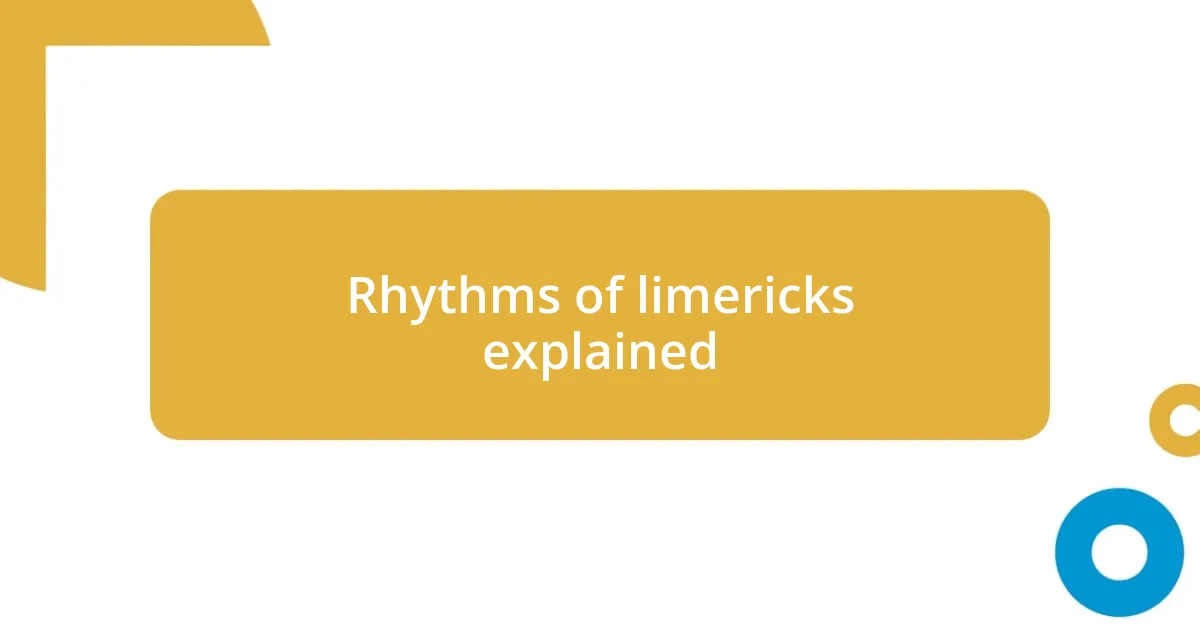Key takeaways:
- Poetic forms provide structure and creative freedom, with each form evoking distinct emotions and imagery.
- Sonnets encourage precise language and emotional depth through their structured format.
- Haikus promote mindfulness by capturing fleeting moments in a concise 5-7-5 syllable structure.
- Free verse allows for fluid expression of thoughts and feelings, embracing the complexity of life.

Understanding poetic forms
Poetic forms serve as the framework for a poet’s expression, guiding the rhythm and structure of their thoughts. I remember the first time I encountered a sonnet; it felt like stepping into a beautifully arranged garden where every word had its precise place. Isn’t it fascinating how different forms can evoke such varied emotions and images?
When I think about free verse, I feel a rush of creativity. It’s liberating! There’s something exhilarating about breaking away from traditional constraints and letting the lines flow organically, just like a stream wandering through a forest. Have you ever wondered how such freedom can open the door to unexpected insights and connections in your writing?
Each poetic form brings its own flavor to the table, creating a diverse palette for expression. For example, haikus invite us to distill moments down to their essence, often capturing the beauty in simplicity. Those little three-line gems remind me of the fleeting nature of life. Can you think of a moment in your life that would fit into that kind of brevity?

Why I love sonnets
Sonnets have always fascinated me with their intricate structure and profound depth. I remember the first sonnet I wrote; it was a challenge, but each line felt like a step toward something beautiful. The tight rhyme scheme and meter pushed me to be precise with my language, resulting in an exhilarating creative process where every word mattered.
Here are a few reasons why I love sonnets:
– Structured Creativity: The rules of the sonnet prompt inventive thinking within constraints.
– Emotional Resonance: They often explore themes of love, loss, and the passage of time, which resonate deeply with me.
– Artistry in Brevity: With just 14 lines, a sonnet encapsulates powerful emotions, making every word a deliberate choice.
– Historical Richness: There’s a connection to literary giants like Shakespeare and Petrarch, which enriches the experience of writing and reading them.

Exploring haikus and their beauty
Exploring haikus has always captivated me, not just for their brevity but for their ability to encapsulate vivid imagery in just a few words. There’s something almost magical about how a 5-7-5 syllable structure can distill complex feelings into a snapshot of nature or an emotional moment. I can still recall sitting under a cherry blossom tree, craftily penning a haiku that captured the fleeting beauty of the petals. Those three lines felt like time stood still for just a moment.
What I find particularly beautiful about haikus is their invitation to mindfulness. Writing one often requires me to focus intently on a singular moment, drawing from my surroundings and emotions. It reminds me of a time while hiking when I jotted down a haiku about the rustling leaves; writing it helped deepen my appreciation for the simple sounds that surrounded me. Don’t you think it’s fascinating how such a concise format can encourage us to slow down and notice the world?
In considering the essence of haikus, they serve as a poetic bridge between what we see and what we feel. They challenge the writer to be precise and intentional, which often leads to deeper introspection. Just the other day, I found myself struggling to capture a particularly intense sunset in just a few lines. The process compelled me to dig deep into my emotions — a true testament to the power of this form.
| Aspect | Haikus |
|---|---|
| Syllable Structure | 5-7-5 |
| Theme | Nature and Moments |
| Purpose | Capture a fleeting moment |

The magic of free verse
The beauty of free verse is its sheer freedom, allowing creativity to flow unbound by traditional structures. I remember the first time I experimented with this form; I wrote without constraints, letting my thoughts spill onto the page in a way that felt exhilarating. Who knew that ditching rhyme and meter could give me such a sense of liberation?
In crafting free verse, you’re free to play with line breaks, rhythm, and imagery, creating a piece that resonates uniquely with your emotions. I once wrote a poem about a rainy day, allowing each line to reflect the unpredictability of the weather and my feelings that day. The result? A dynamic piece that breathed life into the chaos, connecting the reader to the atmosphere in a way structured poetry might not have.
What truly enchants me about free verse is its ability to capture the intricacies of thought and feeling. When I compose, I often think about how genuine it feels to express my voice without the pressure of fitting into a predefined mold. Isn’t it invigorating to embrace the messiness of life in our writing? Free verse has taught me that poetry can be as fluid and complex as the emotions we experience, making the moment of creation feel like a dance of authenticity.

Rhythms of limericks explained
Limericks are like a delightful puzzle, with their distinctive AABBA rhyme scheme that dances off the tongue. When I first encountered limericks, I was immediately drawn to their playful rhythm, often conveyed through a simple yet bouncy meter. It’s remarkable how this form creates a harmonious blend of sound and meaning, making it enjoyable to write and read.
The rhythm typically follows a pattern of anapestic meter, which means you’ll find two unstressed syllables followed by a stressed syllable, creating a lively beat. I remember composing my first limerick about my dog’s quirky habits, and the rhythmic flow seemed to mirror his unpredictable antics. It was such a joy to experiment with how the lines felt as I recited them aloud, truly capturing the essence of the moment.
Writing a limerick not only pushes me to be clever with my word choice but also to embrace humor and whimsy. I often find myself chuckling at the absurdity of some themes I explore. Have you ever noticed how a simple twist at the end can evoke laughter? For me, that punchline is the heart of a limerick, and it inspires a certain lightness that’s truly refreshing in the world of poetry.

Tips for mastering different forms
When I dive into mastering different poetic forms, I often start by reading examples from poets I admire. Something about observing how they shape their lines and play with rhythm sparks my creativity. You might find it helpful to mimic a favorite poem first, allowing yourself to step into another poet’s shoes. It’s such an eye-opening experience to see how your voice can blend with a distinct style.
I also keep a notebook dedicated to each form I’m exploring. For instance, when I was tackling sonnets, I jotted down ideas that aligned with the structure while experimenting with rhyme scheme and meter. There’s something liberating about treating your notebook like a playground—feel free to make mistakes and celebrate those “oops” moments. Isn’t it thrilling when a line unexpectedly shifts your perspective?
Lastly, I make it a point to share my work with friends or writing groups. Their feedback often reveals nuances I hadn’t considered, urging me to rethink my approach. I recall a time when a fellow poet suggested a slight tweak to my haiku; the transformation was remarkable! It’s through this collaborative process that I refine my craft, reminding me that poetry is not just a solitary pursuit but a shared journey of expression.














